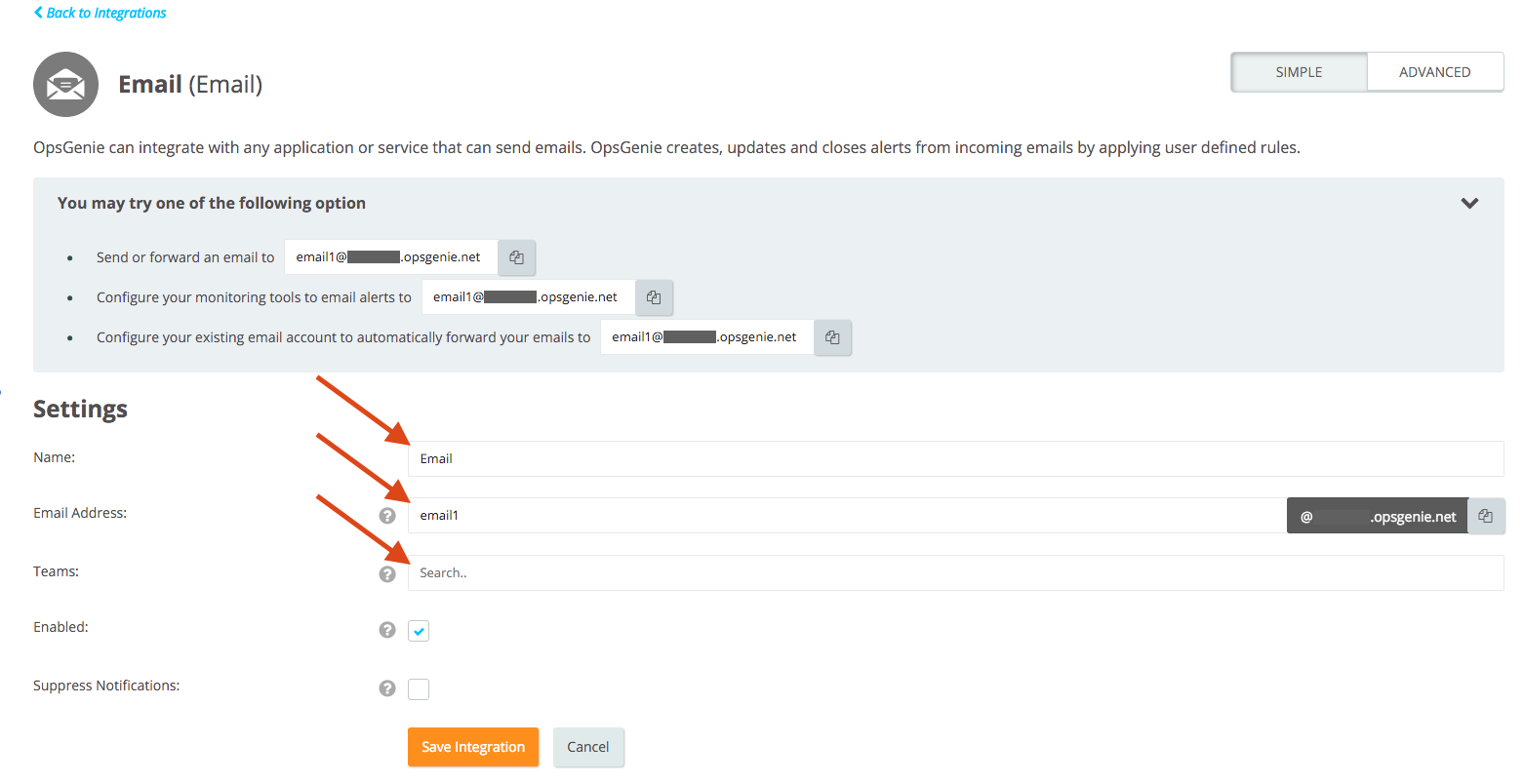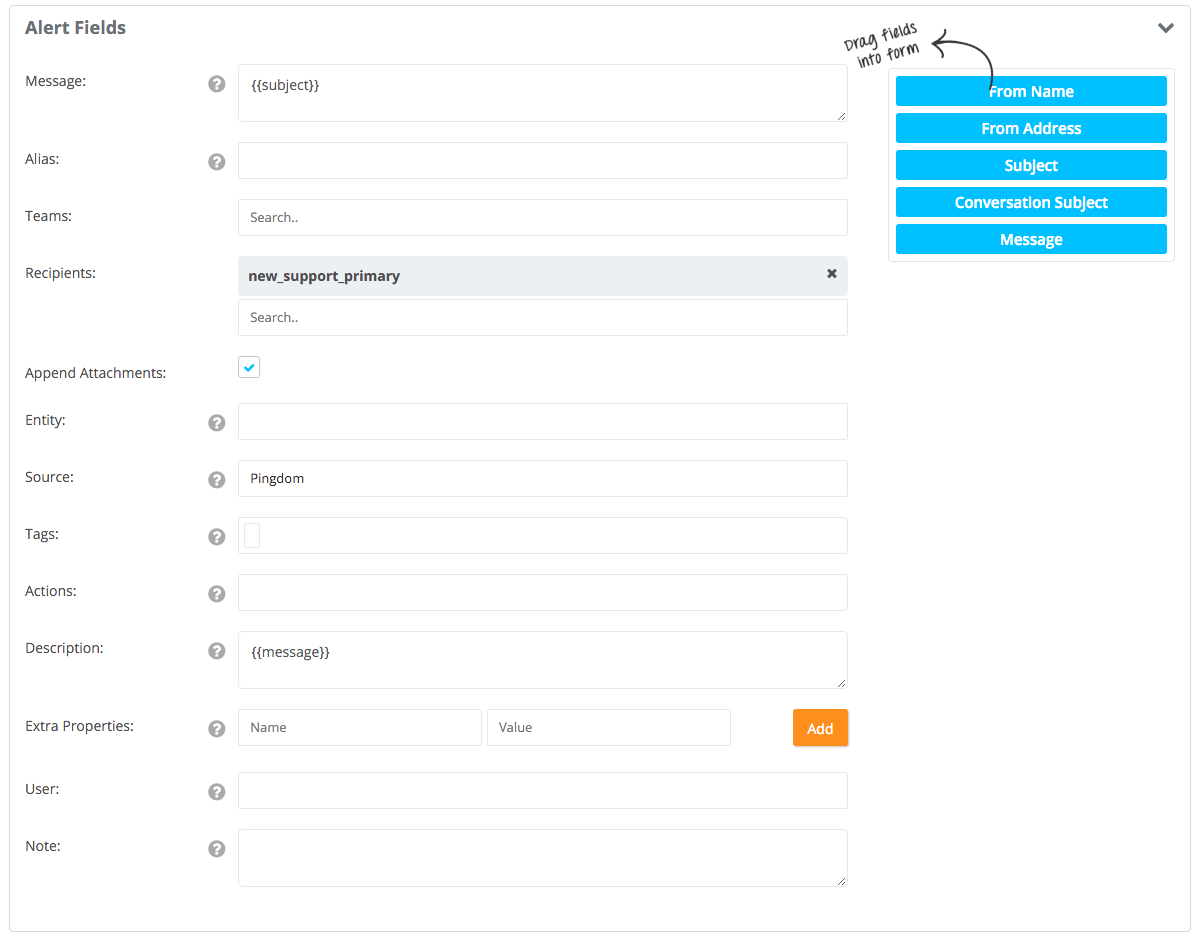Email Integration
Opsgenie integrates with any software or service that is able to send emails. Opsgenie processes incoming emails and create, acknowledge, and close alerts from incoming emails by applying user-defined rules.
Opsgenie provides product-specific Integration Plugins for many popular monitoring tools as well as a Web API and command line utility lamp for integration.
Email based integrations configuration can be done on Integrations page.
Basic configuration to create alerts
- Please create an Opsgenie account if you haven't done so already.
- Go to Opsgenie's Email Integration page.
For Free and Essentials plans, you can only add the integrations from the Team Dashboards, please use the alternative instructions given below to add this integration.
- Each email integration is assigned a customizable email address.
- Specify who is notified of Email alerts using the Teams field. Autocomplete suggestions are provided as you type.
An alternative for Step 2) and Step 4) is to add the integration from the Team Dashboard of the team which will own the integration. To add an integration directly to a team, navigate to the Team Dashboard and open Integrations tab. Click Add Integration and select the integration that you would like to add.
- Optionally, change the name of the integration.
- Click Save Integration.

All done! Opsgenie creates an alert for each email that is sent to the specified email address. By default, email integration uses email subject as the alert message, and email body is put into the alert description field. If the incoming email comes in HTML format, Opsgenie also attaches the original email to the alert.
Email attachment size has limited to maximum 2MBs. If this is reached, the email will be discarded.
- If an email integration is disabled, emails sent to that email address are ignored by Opsgenie.
- If Suppress Notifications is checked, Opsgenie creates alerts, but users do not receive any notifications for the alerts.
Advanced Configuration
The basic configuration allows creating alerts with minimal configuration. Advanced settings allow:
- defining rules to notify different people for different emails
- defining rules to acknowledge or close alerts using resolution/recovery emails instead of creating separate alerts for them
- modifying alert content by parsing the email using String Processing Methods.
The advanced configuration supports a number of different "actions" (different type of rules) that can be applied to emails:
- Ignore
- Create Alert
- Close Alert
- Acknowledge Alert
- Add Note
- Heartbeat
Each action has an associated filter that determines which action is used to process the incoming emails. Each email is processed by only one action, and actions are evaluated in the order they are listed above. For example, if an email matches the filter for a create alert action, it is never used for a close or acknowledge action.
Multiple actions are able to be created for each type of action.
Filters
Filters support 3 types of conditions
- Match all is essentially pass all filter as the name indicates.
- Match one or more conditions below is met if any one of the defined conditions is true (like OR operator)
* Match all conditions below is met only if all the defined conditions are true (like AND operator)
Define filtering rules based on:
- From Name
- From Address
- Subject
- Conversation Subject
- Message fields of the e-mail. Conversation Subject is the subject field of the e-mail ignoring prefixes related to Replying and Forwarding e-mails.
Ignore Action
Some emails may contain no useful information. Ignore action allows discarding the emails that match the defined filter. For example, the following ignore action would discard all emails that contain the string "test" in the email subject.

Create Alert Action
Create alert action creates an alert in Opsgenie if the email passes the defined filter. As stated in the basic configuration, the default configuration uses email subject as the alert message, and body as the description. Create alert action allows customizing how the email is processed. String utilities can be used to extract information from the email and populate alert fields.
The filter below is taken from the Pingdom integration where emails starting with DOWN or FAILING strings indicate a problem.

Create alert action configuration has several fields that can be modified. Opsgenie makes the email information ( from name, subject, etc.) available as variables, and UI supports dragging these variables into alert fields. The values for these fields are specified directly or extracted from the email variables.
- Message field contains the alert text.
- Alias field is a special alert field that plays a critical role in alert processing, and can be thought as the user defined unique identifier for open alerts in Opsgenie. There can be only 1 open alert with the same alias in Opsgenie. This allows Opsgenie to 1) deduplicate same/similar alerts 2) identify alerts, therefore it is setting the alias field properly is essential to be able to update existing alerts (acknowledge, add note, close etc.).
- Teams field is used to determine which team should be notified for the alert. When a team is defined in this field, Opsgenie uses its escalation to determine the users to be notified.
- Entity is the name of the entity that the alert is related to, name of the server, application, etc.
- Source indicates where the alert originated from, typically the name of the monitoring tool or email from address
- Tags are labels used for easier identification and categorization of alerts. Use commas in between for multiple tags.
- Actions: The list of actions a recipient can execute to respond to an alert. Use commas in between for multiple actions.
- Description: Detailed description of the alert; anything that may not have fit in the Message field can be entered here.
- Extra Properties: Additional alert properties. Enter the name of the property in the first field and the value in the second.
- Note is additional text message added to the alert when alert is created.
- User: Owner of the notes which are added to the alert.

Close Alert Action
Opsgenie reduces the number of alerts by using recovery emails to close existing alerts rather than creating separate alerts for them.
As other actions close alert action also has a filter. The filter in the example is taken from the Pingdom integration and closes alerts if the email subject starts with UP or SUCCESSFUL strings.

Close alert action has 3 fields. The alias is the only mandatory field, essential to identify which alert should be closed. If the User and Note fields are provided, then a note is added to the alert before it's closed.

Acknowledge Alert Action
In Opsgenie, acknowledged alerts indicate that someone has seen the alert and taken the responsibility of the alert. When a monitoring tool supports acknowledgment of the alerts and can send an email when an alert is acknowledged, these emails can be used to acknowledge the alert in Opsgenie as well.
Acknowledge alert action configuration is identical to close alert action configuration.
Updated 29 days ago
